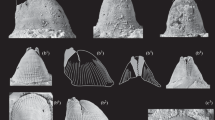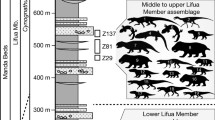Abstract
The morphology of the radial carpal bone (os carpi radiale) of neornithine birds is for the first time evaluated in a comparative context. An unexpected morphological variation of this bone is documented, and characteristic derived morphologies are identified. One of these characterizes a subclade of Accipitridae, which includes the taxa Harpiinae, Circinae, Melieraxinae, Accipitrinae, Milvinae, Haliaeetinae, Buteoninae, and Aquilinae. Another derived morphology of the radial carpal is found in the Picocoraciae, the clade including Coraciiformes sensu stricto, Alcediniformes, Bucerotes, and Piciformes. This latter morphology is absent in Leptosomidae and Trogonidae and constitutes the first morphological apomorphy of Picocoraciae. A distinctive morphology of the radial carpal is further present in passeriform birds. Character variation of the radial carpal provides new data for the evaluation of conflicting phylogenetic hypotheses, and it is detailed that the morphology of this bone further contributes to a phylogenetic placement of controversial avian taxa in the fossil record.







Similar content being viewed by others
References
Baumel JJ, Witmer LM (1993) Osteologia. In: Baumel JJ, King AS, Breazile JE, Evans HE, Vanden Berge JC (eds) Handbook of avian anatomy: nomina anatomica avium, 2nd edition. Publications of the Nuttall Ornithological Club 23:45–132
Bock WJ, McEvey A (1969) The radius and relationship of owls. Wilson Bull 81:55–68
Clark GA (1993) Termini situm et directionem partium corporis indicantes; In: Baumel JJ, King AS, Breazile JE, Evans HE, Vanden Berge JC (eds) Handbook of avian anatomy: nomina anatomica avium, 2nd edition. Publications of the Nuttall Ornithological Club 23:1–6
Clarke JA (2004) Morphology, phylogenetic taxonomy, and systematics of Ichthyornis and Apatornis (Avialae: Ornithurae). Bull Am Mus Nat Hist 286:1–179
Clarke JA, Ksepka DT, Smith N, Norell MA (2009) Combined phylogenetic analysis of a new North American fossil species confirms widespread Eocene distribution for stem rollers (Aves, Coracii). Zool J Linn Soc 157:586–611
Ericson PGP (1999) New material of Juncitarsus (Phoenicopteriformes), with a guide for differentiating that genus from the Presbyornithidae (Anseriformes). In: Olson SL (ed) Avian paleontology at the close of the 20th century: proceedings of the 4th international meeting of the society of avian paleontology and evolution, Washington, D.C., 4–7 June 1996. Smithson Contrib Paleobiol 89:245–251
Ericson PGP, Anderson CL, Britton T, Elzanowski A, Johansson US, Källersjö M, Ohlson JI, Parsons TJ, Zuccon D, Mayr G (2006) Diversification of Neoaves: integration of molecular sequence data and fossils. Biol Lett 2:543–547
Feduccia A (1977) A model for the evolution of perching birds. Syst Biol 26:19–31
Griffiths CS, Barrowclough GF, Groth JG, Mertz LA (2007) Phylogeny, diversity, and classification of the Accipitridae based on DNA sequences of the RAG-1 exon. J Avian Biol 38:587–602
Hackett SJ, Kimball RT, Reddy S, Bowie RCK, Braun EL, Braun MJ, Chojnowski JL, Cox WA, Han K-L, Harshman J, Huddleston CJ, Marks BD, Miglia KJ, Moore WS, Sheldon FH, Steadman DW, Witt CC, Yuri T (2008) A phylogenomic study of birds reveals their evolutionary history. Science 320:1763–1767
Hume JP, Steel L (2013) Fight club: a unique weapon in the wing of the solitaire, Pezophaps solitaria (Aves: Columbidae), an extinct flightless bird from Rodrigues, Mascarene Islands. Biol J Linn Soc 110:32–44
Ksepka DT, Clarke JA (2010) Primobucco mcgrewi (Aves: Coracii) from the Eocene Green River Formation: new anatomical data from the earliest constrained record of stem rollers. J Vertebr Paleontol 30:215–225
Leonard L, Dyke GJ, Van Tuinen M (2005) A new specimen of the fossil palaeognath Lithornis from the Lower Eocene of Denmark. Am Mus Novit 3491:1–11
Lerner HR, Mindell DP (2005) Phylogeny of eagles, old world vultures, and other Accipitridae based on nuclear and mitochondrial DNA. Mol Phylogen Evol 37:327–346
Livezey BC, Zusi RL (2006) Higher-order phylogeny of modern birds (Theropoda, Aves: Neornithes) based on comparative anatomy: I.—methods and characters. Bull Carnegie Mus Nat Hist 37:1–544
Mayr G (1998) “Coraciiforme” und “piciforme” Kleinvögel aus dem Mittel-Eozän der Grube Messel (Hessen, Deutschland). Cour Forsch Inst Senckenberg 205:1–101
Mayr G (2000) A new basal galliform bird from the Middle Eocene of Messel (Hessen, Germany). Senck leth 80:45–57
Mayr G (2008a) The Madagascan “cuckoo-roller” (Aves: Leptosomidae) is not a roller - notes on the phylogenetic affinities and evolutionary history of a “living fossil”. Acta Ornithol 43:226–230
Mayr G (2008b) Phylogenetic affinities of the enigmatic avian taxon Zygodactylus based on new material from the early Oligocene of France. J Syst Palaeontol 6:333–344
Mayr G (2010) Phylogenetic relationships of the paraphyletic “caprimulgiform” birds (nightjars and allies). J Zool Syst Evol Res 48:126–137
Mayr G (2011) Metaves, Mirandornithes, Strisores, and other novelties—a critical review of the higher-level phylogeny of neornithine birds. J Zool Syst Evol Res 49:58–76
Mayr G, Ericson P (2004) Evidence for a sister group relationship between the Madagascan mesites (Mesitornithidae) and the cuckoos (Cuculidae). Senck biol 84:119–135
Mayr G, Micklich N (2010) New specimens of the avian taxa Eurotrochilus (Trochilidae) and Palaeotodus (Todidae) from the early Oligocene of Germany. Paläontol Z 84:387–395
Mayr G, Scofield RP (2014) First diagnosable non-sphenisciform bird from the early Paleocene of New Zealand. J R Soc New Zealand 44:48–56
Mayr G, Mourer-Chauviré C, Weidig I (2004) Osteology and systematic position of the Eocene Primobucconidae (Aves, Coraciiformes sensu stricto), with first records from Europe. J Syst Palaeontol 2:1–12
Pacheco MA, Battistuzzi FU, Lentino M, Aguilar RF, Kumar S, Escalante AA (2011) Evolution of modern birds revealed by mitogenomics: timing the radiation and origin of major orders. Mol Biol Evol 28:1927–1942
Smith ND (2012) Body mass and foraging ecology predict evolutionary patterns of skeletal pneumaticity in the diverse “waterbird” clade. Evolution 66:1059–1078
Vazquez RJ (1992) Functional osteology of the avian wrist and the evolution of flapping flight. J Morphol 211:259–268
Wink M, Sauer-Gürth H (2004) Phylogenetic relationships in diurnal raptors based on nucleotide sequences of mitochondrial and nuclear marker genes. In: Chancellor RD, Meyburg B-U (eds) Raptors worldwide. World working group on birds of prey and owls, Berlin, pp 483–498
Yuri T, Kimball RT, Harshman J, Bowie RCK, Braun MJ, Chojnowski JL, Han KL, Hackett SJ, Huddleston CJ, Moore WS, Reddy S, Sheldon FH, Steadman DW, Witt CC, Braun EL (2013) Parsimony and model-based analyses of indels in avian nuclear genes reveal congruent and incongruent phylogenetic signals. Biology 2:419–444
Acknowledgments
I thank S. Tränkner for taking the photographs and A. Elzanowski for comments on an earlier version of the manuscript. Thoughtful comments by two anonymous reviewers improved the text.
Author information
Authors and Affiliations
Corresponding author
Additional information
Communicated by Andreas Schmidt-Rhaesa.
Rights and permissions
About this article
Cite this article
Mayr, G. Comparative morphology of the radial carpal bone of neornithine birds and the phylogenetic significance of character variation. Zoomorphology 133, 425–434 (2014). https://doi.org/10.1007/s00435-014-0236-5
Received:
Revised:
Accepted:
Published:
Issue Date:
DOI: https://doi.org/10.1007/s00435-014-0236-5




